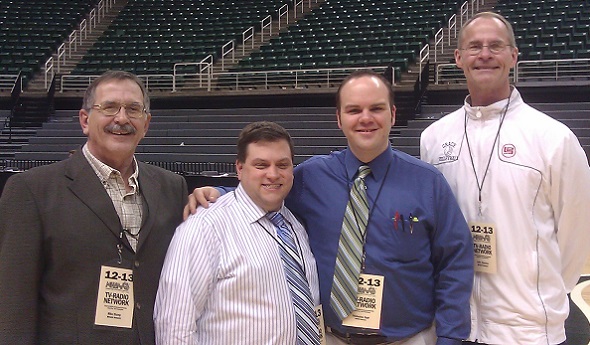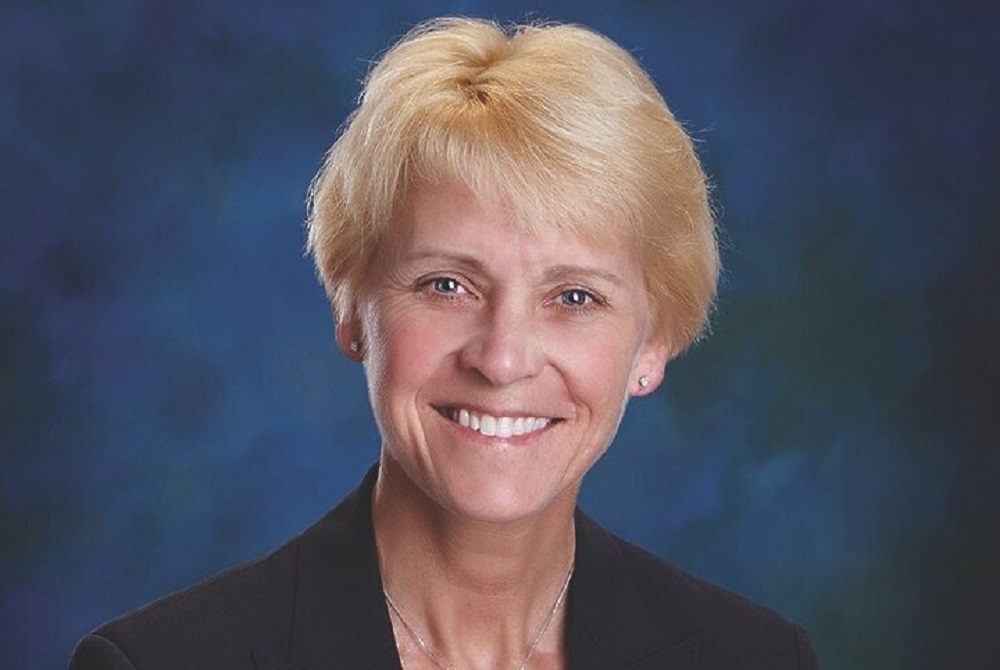
MHSAA Gets Word In During Video Age
September 3, 2014
By Rob Kaminski
MHSAA benchmarks editor
The Buggles’ leadoff single for MTV’s Opening Day on Aug. 1, 1981, started a rally – OK, a revolution – in the music industry that would last decades.
“Video Killed the Radio Star” certainly had a lasting impact, and the song and its one-hit-wonder artist are now an intertwined answer in music trivia lore.
But, the game is still going on. The radio star is far from dead, and, in fact, MTV rarely shows music videos any more.
True, video is everywhere, from laptops to tablets to phones. So, too, is music – and the spoken word in the form of podcasts, audiobooks, and, yes, play-by-play of athletic events.
The MHSAA Network has been providing the latter for prep enthusiasts for decades, entering the world of webcasting around the turn of the millennium.
Having broadcasts available online has done wonders to increase the number of stations and listeners. Prior to the foray into internet broadcasts, dedicated ISDN phone lines and a satellite were required for content to reach the network affiliates.
John Kreger, the primary voice of MHSAA Championships, has been there through the transition, and sees only a bright future ahead.
Prior to the 2003-04 school year, the MHSAA entered a partnership with TBC Sports to air its radio broadcasts for tournaments. Working with TBC owner Will Tieman at that time was Kreger.
“This was before the Network was online, and Will said to me, ‘Hey John, I have a project for you,’” Kreger recalls. “Well, I jumped at the opportunity and he let me run with it. There are times I still want to pinch myself to make sure I’m really able to watch and broadcast all these events.”
After four years with TBC, the MHSAA Network moved its operations to online vendor EZStream, allowing for greater growth and easier access for all involved.
“EZStream really stepped up its quality in recent years, and once our stations no longer needed a satellite receiver, getting games on the air became much simpler,” Kreger said. “All they need to do is point and click to get the feed. It’s a low-cost – almost no-cost – way for stations around the state to tell the story of high school sports.”
No one enjoys telling that story more than Kreger, now in his 11th year calling MHSAA events. His broadcast career has placed him on radio row at Stanley Cup, NBA and MLB playoffs, but it’s talking about his MHSAA Tournament gig that revs his voice to a pitch normally reserved for the final seconds of a prep title game at Ford Field, Breslin or Compuware.
“High school sports is the only pure form of sports left. As a professional reporter and broadcaster I spend most of my year dealing with playing time and sneaker deals,” Kreger said. “But for nine weeks out of the year I get to broadcast sports which the MHSAA has made into a showcase about students, and I am honored to do this. The looks on those kids’ faces when they take the same court or field they see on TV, knowing they reached the pinnacle, there’s no rush like it in sports. I’ll take high school events every day of the week and twice on Sunday.”
The 2008 MHSAA Ice Hockey Final seemed like it might indeed push Kreger into action on a Sunday. The last game of the weekend, the Division 1 tilt between Marquette and Orchard Lake St. Mary’s, went eight overtimes before it was declared a tie. It was one of Kreger’s most memorable moments.
“It was our first year doing hockey on the Network, and being on the air, just being a small part of that, and seeing the MHSAA make the right call and declare a tie; it is something I’ll never forget,” Kreger said. “I’ve been on air enough to hear the cliché, ‘What a great game; too bad someone had to lose,’ too many times, or at times where that might not have been the case. Well, no one deserved to lose that night, and the MHSAA made a great decision. I’m proud to have seen that.”
Thanks to Kreger and the Network, thousands of people continue to “see” games they can’t attend. For the 2014 winter season, approximately 7,000 unique listeners tuned in to the MHSAA Ice Hockey, Girls Basketball and Boys Basketball Finals.
Audio continues to thrive and serve its audiences for a number of reasons.
“Personally, one of the reasons I stay with audio is because we have the opportunity to tell a story and allow the listener to create their own picture,” Kreger said. “Radio broadcasts are much more descriptive, whereas TV broadcasts serve more as guides to what people are already seeing.
“One of my idols is Ernie Harwell, who said, ‘In radio, nothing happens until the broadcaster says it does.’ In that respect, there’s more anticipation and imagination for the listener. Think of the iconic moments like the Bobby Thompson home run. It’s always the radio feed. It takes people back to where they were at the moment.”
That’s another key advantage to audio. If people can’t attend an event, they can listen. Even in today’s world of hand-held video devices, there are times when listening is simply more conducive than watching, whether working around the house, exercising or driving to and from appointments.
“Radio is a lot more accessible to people. It’s a constant companion, and that’s the beauty of it,” Kreger said.
Like its video brethren, audio listeners are turning to mobile devices as the tool of choice. Of the 7,000 customers this past winter, nearly one-third were mobile listeners.
Kreger has been an amiable companion for Michigan prep enthusiasts for the past decade, and he hopes they keep inviting him along wherever their travels take them. He also lauds the MHSAA for expanding its menu.
“The MHSAA is to be commended for expanding the schedule to more than just football and basketball,” Kreger said. “The more sports we can bring to people, the better.”
If Kreger could be in two places at once, there’s no doubt he’d accept the assignment as long as it had the MHSAA stamp on it. Perhaps that’s because his values and perspective are so closely aligned with the mission of school sports and the MHSAA.
“The first rule of high school sports is that this isn’t life. It’s part of life,” he said. “The athletes will become doctors, lawyers and teachers. The coaches are teachers, doctors and auto workers. We don’t sugar coat. I try to be true to the game, to be honest and accurate, and all the while I remember perspective. Above all else, I try to remain respectful of the game.”
PHOTO: The faces behind some of the familiar voices on the MHSAA Network are, from left, Mike Stump, John Kreger, Denny Kapp and John Spooner.

Title IX Continues to Fuel Growth of Girls and Women’s Sports, Olympic Dominance
By
Karissa Niehoff
NFHS Executive Director
September 24, 2021
To say that American female athletes dominated the recent Olympics in Tokyo would be an understatement.
Among the 66 medals earned by American female Olympians – most by any country in the history of the Games – were gold-medal performances by the U.S. basketball, volleyball, water polo and beach volleyball teams. Eighteen medals were earned by the U.S. women swimmers, female track and field athletes claimed 15 medals, and the U.S. women’s softball and soccer teams won silver and bronze medals, respectively.
In the past 30 years of the Olympic Games, the United States has dominated the women’s team sports of basketball (nine golds), soccer (four golds, one silver, one bronze) and softball (three golds, two silvers) — not to mention the untold number of medals in track and field. And this past summer, the U.S. women’s volleyball team claimed its first gold medal.
These performances by some of our nation’s most skilled female athletes never would have been possible without the passage of Title IX and the offerings of these sports through our nation’s schools. With the chance to play afforded by the landmark Title IX legislation in 1972, girls participation in several high school sports skyrocketed in the years that followed.
When the NFHS conducted its first participation survey in 1971, basketball and outdoor track and field were the primary girls sports, comprising about two-thirds of the 294,000 total. However, with the opportunity to play additional sports, girls flocked to volleyball and softball first, along with cross country and eventually soccer.
Soccer, in fact, has had the most remarkable growth. In 1971, only 700 girls were playing high school soccer. Twenty-five years later, that number had climbed to almost 210,000; and as the 50th anniversary of Title IX approaches, there are now almost 400,000 girls playing high school soccer – a staggering 56,200 percentage increase in 50 years. Soccer now ranks fourth in popularity among girls high school sports – all because of that opportunity in 1972.
There are many other success stories, however. The pre-Title IX survey in 1971 indicated that 1,719 girls were participating in cross country. With increases every year until 2015, today, there are 219,345 girls competing in high school programs and the sport ranks sixth in popularity.
Although participation numbers have leveled a bit the past 10 years, fast-pitch softball is another sport that flourished after the passage of Title IX. With fewer than 10,000 participants in 1971, the numbers quickly rose to 220,000 by 1985 and 343,000 by 2000, and softball is currently fifth among girls sports with 362,038 participants.
Since track and field and basketball were the primary sports in the early days of girls sports programs, increases in those sports have not been as dramatic; however, they remain the first and third most-popular sports, respectively, today. Volleyball, however, much like soccer, continues its upward climb.
Without a doubt, volleyball has seen the steadiest increases among girls high school sports the past 50 years. After starting with 17,952 participants in 1971, the numbers jumped to 300,810 by 1990 and 409,332 by 2010 and 452,808 by 2018. During its climb, volleyball surpassed basketball as the No. 2 girls sport.
And among the top six girls sports from 2010 to 2018 (numbers are not available the past two years due to the pandemic), volleyball has gained the most participants (43,476), followed by soccer (32,549). And all of this has occurred thanks to legislation passed in 1972 that was not fundamentally meant to address opportunities for girls to participate in high school sports.
The NFHS is leading a yearlong celebration of the 50th anniversary of Title IX, which officially occurs on June 23, 2022. “Title IX at 50 – Celebrating and Growing Opportunities” is highlighting the law’s impact by celebrating the inspirational individuals and landmark moments in the history of Title IX, and continuing to grow the educational and competitive opportunities for the future.
More information, including a Title IX Timeline, Title IX Milestones, The History and Importance of Title IX, Title IX Fact Sheet, Title IX Frequently Asked Questions and several Title IX videos, can be accessed on the NFHS Website.
Dr. Karissa L. Niehoff is beginning her fourth year as executive director of the National Federation of State High School Associations (NFHS) in Indianapolis. She is the first female to head the national leadership organization for high school athletics and performing arts activities and the sixth full-time executive director of the NFHS. She previously was executive director of the Connecticut Association of Schools-Connecticut Interscholastic Athletic Conference for seven years.

